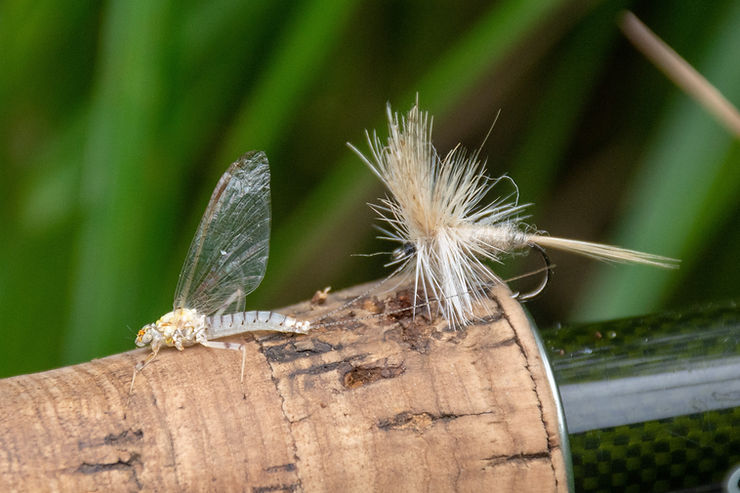White Flies on Yellow Breeches

I pulled into the parking lot behind the Allenberry Resort in Boiling Springs a couple hours before dark, just as the evening was starting to cool from the mid-August heat. I thought I was plenty early, and most times of year I would’ve been, but this was Yellow Breeches Creek, and the White Flies were on.
The White Fly isn’t just a hatch. It’s an event. In many of the waters where this species emerges, the spring mayfly fly hatches are a distant memory and the fall mayfly hatches uncertain. And right there in between, in the dog days of summer, is the White Fly, like a little oasis for fly fishers.
The White Fly (Epheron leucon) is a roughly size 14 mayfly not found on most Pennsylvania trout streams. Several famous waters have the hatch, such as the Little Juniata River, Penns Creek, and Oil Creek, as well as a score of lesser-known streams, but the White Fly gets its glory from its appearance every July and August on the Susquehanna River and Yellow Breeches Creek. While the fishing on the Susquehanna is primarily for Smallmouth Bass, on Yellow Breeches it’s all about trout. And it brings people from hours away just to experience it.
As I walked along the banks behind the Allenberry, I encountered a husband and wife fishing team who’d driven from Virginia that afternoon just to fish the hatch that evening. It was the 22nd year in a row that they’d made the trip. Further downstream, I met a guy from Baltimore sitting with his back against a tree, studying the water for signs of activity. Downstream from him, nine guys lined up on one side of a deep run, all of them conversing and joking around and checking the time as if they were waiting for 8 a.m. on opening day of trout. Like I said, the White Fly hatch is an event.
The most popular section on Yellow Breeches is the Catch and Release Artificial Lures Only (CRALO), which begins at the Run (the outflow of Children’s Lake in Boiling Springs) and extends about a mile downstream to the Allenberry Resort. The water coming out of the Run is a cool 55 degrees year-round, and the CRALO is stocked heavily. Fortunately, not every part of the stream gets that crowded, and solitude can be found on stretches outside of the special regulations area, even when the hatch is at its peak.
Yellow Breeches begins in Michaux State Forest and flows approximately 40 miles to its confluence with the Susquehanna River, and most of it contains populations of both wild and stocked trout. Talk to the regulars who fish it often, and you’ll likely hear the phrase, “It’s a limestone stream, but it fishes like a freestoner.” Translation: It’s a fertile stream with abundant mayfly hatches, but the fish aren’t nearly as spooky or as hard to catch as they are in typical spring creeks such as Falling Spring Branch or Big Spring Creek.
You can encounter insect activity almost any day of the year on Yellow Breeches. Even when no major hatches are taking place, you can usually find at least a scattering of mayflies or caddis coming off somewhere. The White Fly, however, is primarily found in the lower half of the stream, below Mount Holly.

(Photo: In most situations, a similar-sized Light Cahill is an adequate match for the White Fly.)
The White Fly hatch on Yellow Breeches begins in early to mid-August and lasts about a month. As the hatch progresses, the naturals tend to get smaller. In the beginning, it’s not uncommon to find flies as big as size 12 and 14. Several weeks later, most of those flies will range from size 16 to 18, and occasionally smaller. Even later in the hatch, though, when the flies are smallest, a pattern a size or two bigger than what’s hatching can still work, and they’re a lot easier to see in low-light conditions when the flies tend to emerge.
Light Cahills or any pattern with cream hackle and dubbing in appropriate sizes will imitate the White Fly just fine. More important than perfectly matching the hatch is how you present the fly to the fish. It’s summer, after all. Low water and skittish fish can make for challenging conditions. Long leaders and fine tippets are the rule rather than the exception.
The flatter the water, the longer I like my setup. A 9 1/2-foot tapered 6x leader with a two-foot section of 7x tippet is a good starting point. I use a 9-foot 6-weight rod which allows me to make longer casts and reach fish without having to walk right up on them.
During the peak of the hatch, it’s not uncommon to begin the evening fishing over a good emergence of Brown Drakes. These comparatively huge mayflies, size 8, provide a nice lead-in to the White Fly right before dark. Sometimes the White Fly will continue on after dark, too, so be sure to bring a small flashlight or headlamp for changing flies after the natural light is gone.
Most years, White Flies continue to appear well into September on Yellow Breeches, but their emergence becomes more spotty and less predictable. By then, you can sense summer winding down, and on some cool days, there’s even a hint of autumn in the air. Don’t miss out on this unique hatch. The White Fly is nature’s summer farewell gift to fly anglers.
Sign up for the Dark Skies Fly Fishing e-newsletter
It's free, delivered to your inbox approximately three times each month. Your information is always kept private and used for the sole purpose of keeping you up to date on blog posts and specials in the online store.
Sign Up Now